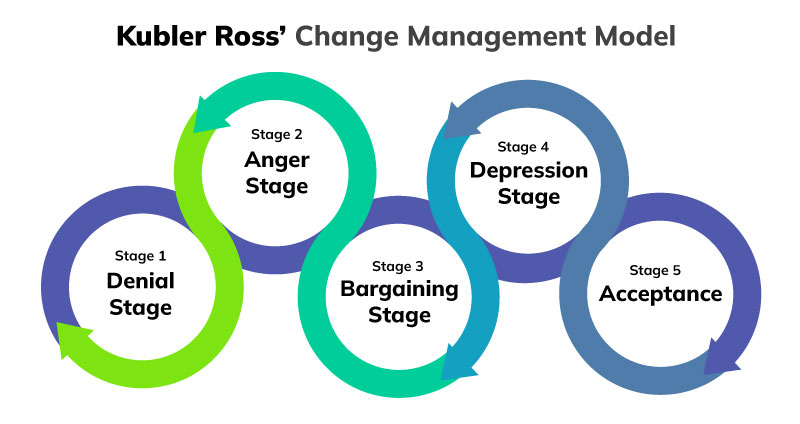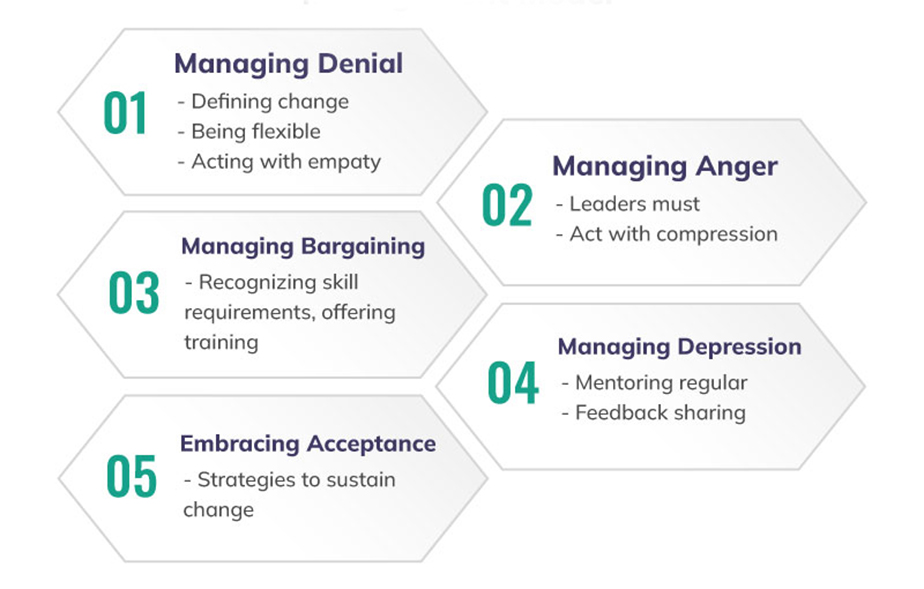Overview of the model
The Kubler-Ross framework for change management, also known as the Kubler-Ross’ Five Stage Change Curve Model was proposed by Elisabeth Kubler-Ross in the 1960s. As the Satir change model was designed for families, this model was specifically designed to deal with human psychology. However, Elisabeth’s Kubler-Ross model finds wide application even in the modern business world. Elisabeth Kubler-Ross was a Swiss-American Psychiatrist and her change management model finds wide application even in the modern business world. In fact, the Kubler-Ross Curve is one of the most credible and reliable change management tools given its ease of use.
Kubler-Ross divided the organizational change management process into five stages linked to human behaviors. These stages are also described as the 5 stages of grief that are used to forecast the response of people to a specific change. The five stages of grief are illustrated below with concise explanations.

Table of Contents
Stage 1: The denial stage
As per Kubler-Ross’ framework, this is the first stage of grief where people are in denial of an unfavorable development or change. In this stage, people put up short-lived defense mechanisms to resist the developments linked to a change. In simpler terms, in this stage, people have acceptance issues with regard to change in the status quo.
Stage 2: The anger stage
When the realization happens that the change is inevitable, people can no longer be in denial and they respond with frustration and anger. Besides, subject to their personal behaviors, people manifest anger in different ways. All in all, at this stage people begin to have temperamental issues.
Stage 3: The bargaining stage
After the anger subsides, in the next stage of grief people start exploring ways in which they can bargain with the change. In simpler terms, they look to postpone the change or restrict the inevitable. There would always be some people who would look to avoid changes and they will view this stage as an opportunity to do so.
Stage 4: The depression stage
By this stage, people or employees start getting overwhelmed by negative emotions of dejection, sadness, regret, and anxiety. In the case of employees, by the time this stage arrives, they start getting disengaged and begin to feel unmotivated and unproductive.
Stage 5: The acceptance stage
In the final stage, after trying to resist and bargain the change for a long time, people finally accept the change realizing they may have no other choice. They surrender their resistive attitude and begin to participate in the change process with positive contributions.
Application of the Kubler-Ross’ Change Management Framework

Managing the denial stage
In the context of organizational change management, leaders or managers need to handle employees’ denial effectively and with flexibility. Leaders need to explain to resisting employees why the transition is necessary and why it is for the greater good. Besides, they should give employees their fair share of time to understand the change and also guide them through the same. Besides, not only do the managers need to communicate effectively but they also need to act with patience and empathy.
Managing the anger stage
In the next stage where denial is over, employees may react with great resentment to change which may also be exhibited in the form of fierce anger. The management has to be sensitive at this stage and should play a proactive role in helping employees get over their fears linked to the change. The management needs to acknowledge that changes may trigger insecurities among employees and it is normal to feel so. Hence, they should continue to back their employees with support and present the change in a positive light. It is imperative to not respond to anger with anger as that can lead to chaos and uncontrollable workplace conflicts. Compassion has to be at the forefront while managing this stage.
Managing the bargaining stage
In the bargaining stage, employees will seek answers to how they can adapt to the change and what adjustments they need to make so that they can align with the change. In this aspect, the management should look to optimize employees’ learning experience by offering effective training and mentoring programs. The management needs to recognize the knowledge, skills, and competencies that employees require to keep pace with the transition. Subsequently, training modules and styles of learning should be planned.
Managing the depression stage
As employees are exposed to new learning and skill-building requirements, they may find themselves in dejection. Needless to say, when employees have to incorporate new skills and grasp new knowledge along with completing their work commitments, they will experience high stress. In some cases, employees may even start witnessing burnout situations along with the decline in productivity and motivation. To help employees in such situations, the management should make learning more fun and engaging. Also, regular feedback needs to be shared and learning effort and outcomes should be appreciated. Organizations can embrace gamified learning solutions and micro-learning modules to make demanding learning experiences less exhaustive.
Embracing the acceptance stage
When employees finally begin to accept the change and are ready to contribute positively to the process, managers need to see this as an opportunity to embed the change in the natural culture of the organization. Besides, the management needs to find ways to improve the outcomes of the change and get better results out of it. From the denial stage to acceptance, it is observed that the above course of action is similar to the Bridges’ Transition Model. It also deals with letting go of the old phase to switching over to the new beginnings. It is therefore important to embrace change by positively looking forward to a better future. For that, the top management needs to develop strategies to sustain the change and enhance the performance.
Kubler-Ross’ Change Management Framework example taking Procter & Gamble’s case
Over the last few years, P&G, one of the leading multinational companies in the consumer goods industry, brought major changes to its recruitment policies. The company has now integrated AI solutions in its hiring policies for better candidate experiences and refined hiring practices. So, let us try to understand how this change was facilitated using Kubler-Ross’ change management model.
Denial stage
When the change was initiated, the recruiters were in the denial stage thinking AI in recruitment will replace them and put their careers at risk. They showed great resentment toward the change. In such a situation, the top management and top recruiters understood the emotions of team members and extended empathy. Besides, through open communication policies, they tried to clear the misconceptions that AI will replace recruiters. The management effectively explained to them that AI will boost their recruitment efficiency and not replace them, and even encouraged employees to explore relevant ai courses to better understand and leverage these tools.
Anger Stage
When the recruitment team realized that the change is inevitable, they manifested great anger and might portray aggressive behaviors. In such a situation, the top management acted with patience and calmed them down by showing respect for their emotions. They understood that people in the recruitment team have insecurities about their careers because of AI systems being integrated. Leaders acted with great efficiency to help employees accept the idea of the change.
Bargaining Stage
In this stage, the top management and the project managers provided training in AI systems and their effective utilization. The recruitment team received extensive training to learn how they can optimize candidate experiences and hiring efficiency with the smart use of AI. This helped the team members a great deal to adjust to the change and find ways to fit in.
Depression Stage
The team members in the recruitment team felt overwhelmed with increasing workload while managing their work on the sidelines of learning about AI systems and their utilization in recruitment. For that, P&G’s top management and trainers used gamified learning modules to make training more fun and engaging. Also, celebrating small wins helped to absorb negative emotions among team members. Lastly, continuous feedback sharing helped the team to overcome the feelings of demotivation and disengagement. Various engagement strategies were planned by leaders and project managers to keep the morale high.
Acceptance Stage
In the final stage, the team members accepted the change and started embracing AI solutions in recruitment processes. This is where the leaders further worked on making the change more concrete in the organization and would have created strategies to sustain the change and its positive impacts in the future. KPIs were set for tracking the performance of AI-based recruitment solutions with candidate experience being a significant metric to measure the success of this integration. Moreover, P&G is constantly working on improving the effectiveness of its recruitment processes by optimizing the scope of getting the best of AI in recruitment.
FAQs
How can Kübler-Ross's Change Management Framework be applied in managing change?
Understanding the emotional stages of change can help change leaders and managers anticipate and address the reactions of individuals during the change process. By acknowledging and supporting employees through their emotional journey, leaders can foster a smoother transition and increase the likelihood of successful change adoption.
Are the stages in Kübler-Ross's model strictly sequential?
No, the stages in Kübler-Ross's Change Management Framework are not always experienced in a strict sequential order. Individuals may move back and forth between stages, skip certain stages, or experience them in a different sequence. Each person's response to change is unique, and the model serves as a general guide rather than a rigid roadmap.
Pervious Model
Bridges’ Transition ModelNext Model
Satir Change Model
 Proof Reading
Proof Reading  Copy Writing
Copy Writing  Resume Writing
Resume Writing  Blogs
Blogs Guides
Guides SOP's
SOP's Student Resources
Student Resources Research Topics
Research Topics Login
Login Register
Register